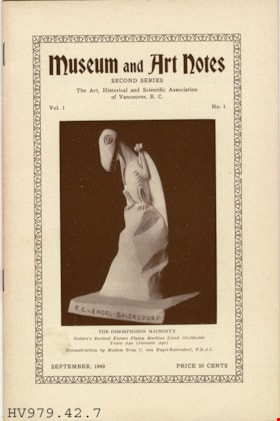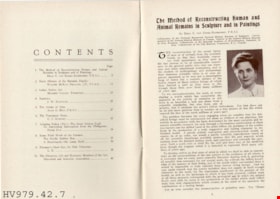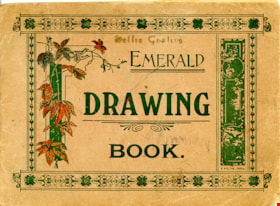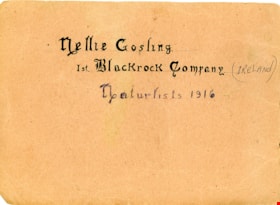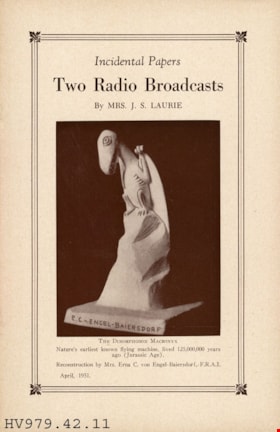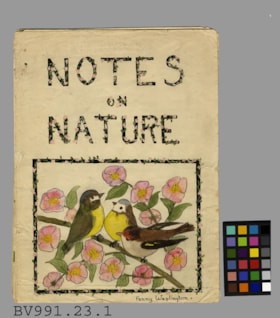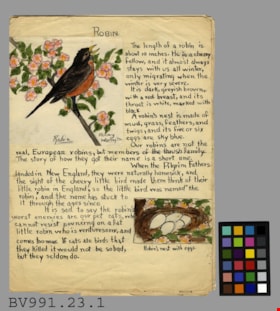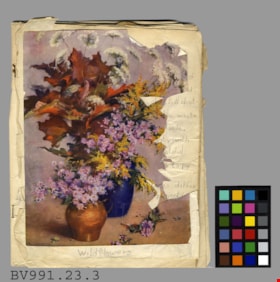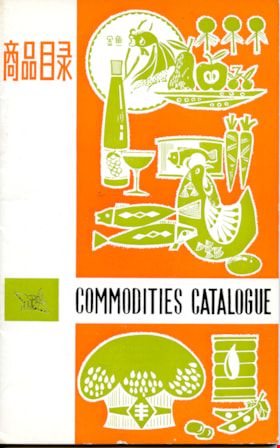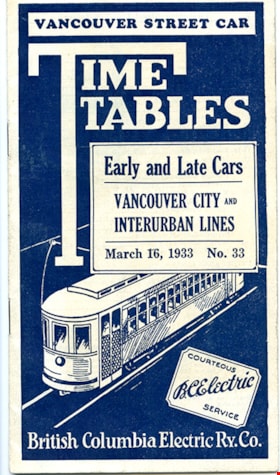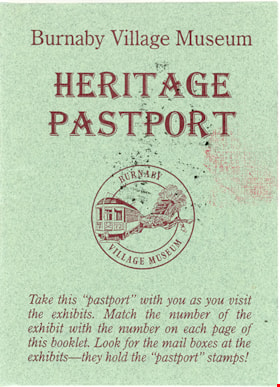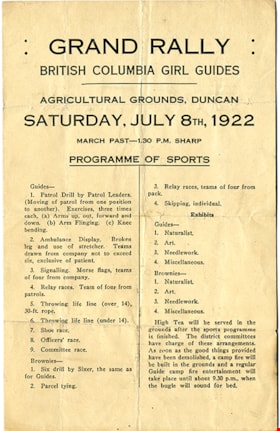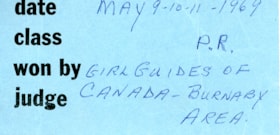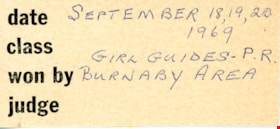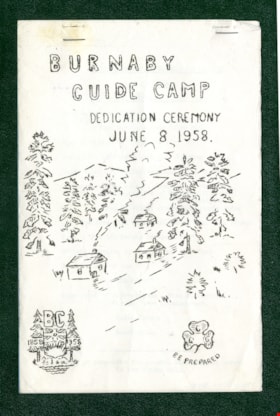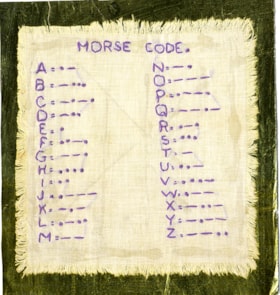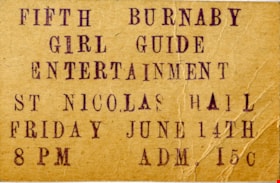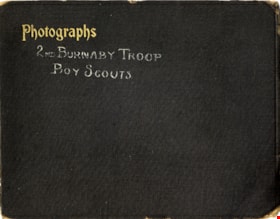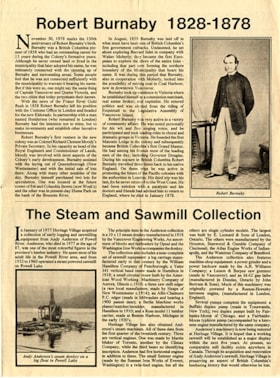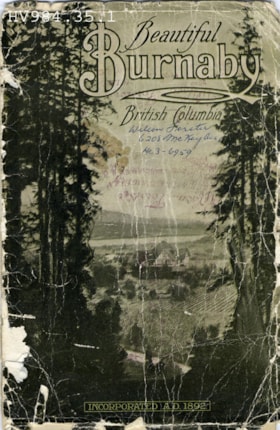More like 'booklet'
Narrow Results By
Subject
- Agriculture 1
- Agriculture - Farms 1
- Arts - Paintings 1
- Buildings - Commercial - Grocery Stores 1
- Buildings - Commercial - Restaurants 1
- Cemeteries 1
- Clothing - Accessory 8
- Clothing - Uniforms 8
- Documentary Artifacts 11
- Documentary Artifacts - Booklets 8
- Documentary Artifacts - Leaflets 2
- Documentary Artifacts - Magazines 1
booklet
https://search.heritageburnaby.ca/link/museumartifact17357
- Repository
- Burnaby Village Museum
- Accession Code
- HV979.42.7
- Description
- Museum & Art Notes - Booklet -- [1949]. The Art Historical and Scientific Association publication of Museum & Art Notes. This is Volume 1, Number 1 of the Second Series, September 1949. The front cover features a picture of the Dimorphodon Macronyx model made by Madam Erna C. von Engel-Baiersdorf. This issue has articles on: The Method of Reconstructiong Human and Animal Remains in Sculpture and in Paintings Early History of the Burnaby Family Indian Native Art Sundews The Aleuts of Attu The Trumpeter Swan Achatina Fulica, The Great African Snail Some Field Work of the Curator Palomar's Giant Eye, the Hale Telescope The Directors, Life and Honorary Members of the Art, Historical and Scientific Association.
- Subjects
- Documentary Artifacts
- Documentary Artifacts - Booklets
- Organizations
- Organizations - Art Societies
- Organizations - Historical Societies
- Organizations - Science Societies
Images
Documents
drawing book
https://search.heritageburnaby.ca/link/museumartifact87479
- Repository
- Burnaby Village Museum
- Accession Code
- BV015.35.89
- Description
- drawing book; brown paper book of sketches from nature; 27 pages; hand drawn and painted; botanical samples of pressed wildflowers are also adhered to pages inside book and identified; "EMERALD / DRAWING / BOOK." commerically printed on front cover in green ink along with illustrations; "Nellie Gosling" handwritten on front cover in black ink; "Nellie Gosling / 1st Blackrock Company (Ireland) / Naturalists 1916" handwritten inside front cover; hand drawn and coloured flag display "UNITED WE STAND" on last page of book; flags of World War I allies Italy, France, Belgium, Great Britain, the United States of America, Portugal, Russia and Japan.
- Object History
- Drawing book was created by Nellie Gosling, First Blackrock Company, Ireland. The book may have been created to earn a badge. The drawing book was donated with items belonging to Dorothy Pitman, but it is unknown how she acquired it since she doesn't appear to have done the drawings herself. Dorothy Pitman was a Girl Guide in the 1st Burnaby Company. She was known to be involved with guiding from 1919 to 1931. Textual records and photographs of the Pitman family, including one of Dorothy and her sister Gwen, are held by the City of Burnaby Archives. Dorothy and Gwen's parents, Ernest and Jean Pitman, owned McKay Dry Goods and Jubilee Dry Goods.
- Category
- 04.Tools & Equipment for Materials
- Classification
- Painting T&E
- Object Term
- Sketchbook
Images
Documents
booklet
https://search.heritageburnaby.ca/link/museumartifact17361
- Repository
- Burnaby Village Museum
- Accession Code
- HV979.42.11
- Description
- Two Radio Broadcasts - Booklet -- [1951]. Incidental Papers, Two Radio Broadcasts by Mrs. J. S. Laurie. The front cover features a picture of The Dimorphodon Macronyx reconstructed by Erna C. von Engel-Baiersdorf. The booklet was printed in April 1951.
Images
Documents
booklet
https://search.heritageburnaby.ca/link/museumartifact34033
- Repository
- Burnaby Village Museum
- Accession Code
- BV991.23.1
- Description
- Notes on Nature - Booklet. Handmade booklet by Fanny Waplington called "Notes on Nature". The front cover has a hand painted picture of three birds on a branch filled with pink flowers. The booklet is filled with handwritten pages on birds, plants, trees and insects.
- Object History
- Nature Book was created by Frances Fleming (nee Waplington) while she attended Douglas Road School
- Category
- 08. Communication Artifacts
- Classification
- Documentary Artifacts - - Graphic Documents
- Object Term
- Book
- Colour
- Beige
- Measurements
- 22.5cm x 30.5cm
- Title
- Notes on Nature
Images
Documents
booklet
https://search.heritageburnaby.ca/link/museumartifact34035
- Repository
- Burnaby Village Museum
- Accession Code
- BV991.23.3
- Description
- Wild Flowers - Booklet -- [1925]. School booklet created by Fanny Waplington. The front cover is a cut out illustration of two vases filled with flowers and plants from a magazine. The cover is cut along the right edge. Inside the booklet has handwritten entries about various animals and plants. Most of the entries have a corresponding picture.
- Object History
- Scrapbook journal was created by Frances "Fanny" (Waplington) Fleming while she was a young student.
- Category
- 08. Communication Artifacts
- Classification
- Documentary Artifacts - - Graphic Documents
- Object Term
- Book
- Measurements
- 18.5 x 24.3 cm
- Title
- Wildflowers
Images
Documents
catalogue
https://search.heritageburnaby.ca/link/museumartifact90874
- Repository
- Burnaby Village Museum
- Accession Code
- BV019.6.11
- Description
- Commodities Catalogue; China National Cereals, Oils & Foodstuffs Import & Export Corp; text in English and Chinese; glossy cover; bifold binding with two staples; 52 pages; title page and table of contents; import and export "Branches" in China and Hongkong and Macao Agents listed on inside of back cover; annotations in pen and pencil on last page and inside of back cover.
- Object History
- Publication "Commodities Catalogue", was part of a scrapbook created by Cecil Chue Kan Lee documenting the time he was employed as a Prodcue Buyer for Kelly Douglas and Company Limited and Western Commodities Limited in the 1970s and early 1980s. As a produce buyer for Kelly Douglas, Cecil Lee worked closely with local farmers along Marine Drive and in the Fraser Valley. The Burnaby company was one of the largest food distributors in Canada. In the mid-1970s, Lee was asked to oversee the import of Chinese mandarin oranges into Canada. Until that time, mandarin oranges had come from Japan and were sold in the winter, especially at Christmas. When the Japanese market could no longer keep up with demand, Kelly Douglas looked to China. The company relied on Lee’s cultural knowledge to build this very profitable part of their business.
- Reference
- The first few pages and the last page of this publication are available for viewing on Heritage Burnaby. Contact Burnaby Village Museum to view entire content.
- For other records in this collection see: Business records series of Julie Lee and Cecil Lee family fonds
- Category
- 08. Communication Artifacts
- Classification
- Advertising Media
- Object Term
- Catalog, Sales
- Country Made
- China
- Site/City Made
- Peking
- Title
- Commodities Catalogue
Images
Documents
schedule
https://search.heritageburnaby.ca/link/museumartifact25116
- Repository
- Burnaby Village Museum
- Accession Code
- HV975.19.7
- Description
- Vancouver Street Car Timetables - Booklet -- [1933]. The cover is blue and white with a drawing of a street car. "VANCOUVER STREET CAR/ TIME TABLES". This schedule shows street car and interurban tram times and includes early and late cars. The schedule is for Vancouver City and Interurban Lines. The timetable was printed for March 16, 1933 by the British Columbia Electric Railway Company.
- Country Made
- Canada
- Province Made
- British Columbia
- Site/City Made
- Vancouver
- Title
- Vancouver Street Car Time Tables
- Publication Date
- March 16 1933
- Subjects
- Documentary Artifacts
- Documentary Artifacts - Booklets
- Transportation
- Transportation - Electric Railroads
Images
Documents
souvenir booklet
https://search.heritageburnaby.ca/link/museumartifact91080
- Repository
- Burnaby Village Museum
- Accession Code
- BV020.5.1803
- Description
- Souvenir booklet; cover with brown ink printed on light blue card stock; two staple binding at centre; pages within numbered 1-35; cover reads: "Burnaby Village Museum / HERTIAGE PASTPORT / Take this "pastport" with you as you visit / the exhibits. match the number of the / exhibit with the number on each page of / this booklet. Look for the mail boxes at the / exhibits - they hold the "pastport" stamps!"; circular logo of Burnaby Village Museum with carousel horse and interurban tram; pages within contain stamps taken from the various exhibits inside Burnaby Village Museum.
- Object History
- Item was found in Burnaby Village Museum printshop along with other Heritage Village / Burnaby Village Museum ephemera created between 1971 and [2000].
- Category
- 08. Communication Artifacts
- Object Term
- Souvenir
- Colour
- Blue
- Brown
- White
- Black
- Measurements
- 11.5 x 7.5 cm
- Maker
- Burnaby Village Museum
- Country Made
- Canada
- Province Made
- British Columbia
- Site/City Made
- Burnaby
- Publication Date
- [200-]
- Names
- Burnaby Village Museum
Images
Documents
leaflet
https://search.heritageburnaby.ca/link/museumartifact90017
- Repository
- Burnaby Village Museum
- Accession Code
- BV015.35.321
- Description
- leaflet; buff paper with black text reading: "GRAND RALLY / BRITISH COLUMBIA GIRL GUIDES / AGRICULTURAL GROUNDS, DUNCAN / SATURDAY, JULY 8th, 1922"; rally had a programme of sports events, followed by a high tea, and in the evening, a camp fire with entertainment.
- Object History
- Leaflet is a part of scrapbook "Burnaby Girl Guides. -- [1914]-1969, predominant ca. 1920" (BV015.35.164)
- Note in blue ink on scrapbook page reads: "Burnaby Guides attended this Rally".
- Category
- 08. Communication Artifacts
- Classification
- Documentary Artifacts
- Measurements
- L: 22.2 cm W: 13.9 cm
- Country Made
- Canada
- Province Made
- British Columbia
- Names
- Girl Guides of Canada
Images
Documents
prize ribbon
https://search.heritageburnaby.ca/link/museumartifact90012
- Repository
- Burnaby Village Museum
- Accession Code
- BV015.35.346
- Description
- prize ribbon; yellow satin; bottom is notched; stamped in gold ink: "GUILDFORD / TOWN CENTER / FESTIVAL OF / FLOWERS / SPECIAL / AWARD"; the festival was held at Guildford Town Center from Sept. 13 to 20, 1969; award won by Burnaby area guides.
- Object History
- Prize ribbon is a part of scrapbook "Burnaby Girl Guides (pg 82) . -- [1914]-1969, predominant ca. 1920" (BV015.35.164).
- Reference
- See also Burnaby Girl Guides fonds
- Category
- 08. Communication Artifacts
- Classification
- Personal Symbols - - Achievement Symbols
- Object Term
- Prize
- Measurements
- L: 22.0 cm W:5.0 cm
- Country Made
- Canada
- Province Made
- British Columbia
- Subjects
- Organizations - Girls' Societies and Clubs
- Documentary Artifacts - Reports
- Events - Competitions
- Names
- Girl Guides of Canada
Images
Documents
prize ribbon with tag
https://search.heritageburnaby.ca/link/museumartifact90027
- Repository
- Burnaby Village Museum
- Accession Code
- BV015.35.344
- Description
- prize ribbon with tag; purple satin; top is cut on a slant, bottom is notched; stamped in gold ink: "BURNABY / RHODODENDRON / & / SPRING / FLOWER / SHOW SOCIETY / AWARD / OF / MERIT"; blue paper informational tag indicates that the festival was held May 9 to 11, 1969, and that award was won by the Girl Guides of Canada - Burnaby Area in the Class P.R.
- Object History
- Letter is a part of scrapbook "Burnaby Girl Guides. -- [1914]-1969, predominant ca. 1920" (BV015.35.164) Note in black ink on scrapbook page reads: "Awards / won by / Burnaby / Brownies & Guides / 1969".
- Category
- 08. Communication Artifacts
- Classification
- Personal Symbols - - Achievement Symbols
- Object Term
- Prize
- Measurements
- L: 27.5 cm W:5.0 cm
- Country Made
- Canada
- Province Made
- British Columbia
- Names
- Girl Guides of Canada
Images
Documents
prize ribbon with tag
https://search.heritageburnaby.ca/link/museumartifact90028
- Repository
- Burnaby Village Museum
- Accession Code
- BV015.35.345
- Description
- prize ribbon with tag; red satin; top is cut on a slant, bottom is notched; stamped in gold ink: "THE / AMERICAN / RHODODENDRON / SOCIETY / VANCOUVER / CANADA / B.C. / CHAPTER / SPECIAL / A W A R D / 1970"; cream paper informational tag indicates that the festival was held Sept. 18 to 20, 1969 (should read 1970), and that award was won by the Girl Guides of Canada - Burnaby Area in the Class P.R.
- Object History
- Letter is a part of scrapbook "Burnaby Girl Guides. -- [1914]-1969, predominant ca. 1920" (BV015.35.164) Note in black ink on scrapbook page reads: "Awards / won by / Burnaby / Brownies & Guides / 1969".
- Category
- 08. Communication Artifacts
- Classification
- Personal Symbols - - Achievement Symbols
- Object Term
- Prize
- Measurements
- L: 27.5 cm W:5.0 cm
- Country Made
- Canada
- Province Made
- British Columbia
- Names
- Girl Guides of Canada
- Geographic Access
- Vancouver
Images
Documents
program
https://search.heritageburnaby.ca/link/museumartifact90026
- Repository
- Burnaby Village Museum
- Accession Code
- BV015.35.343
- Description
- program; "BURNABY / GUIDE CAMP / DEDICATION CEREMONY / JUNE 8, 1958."; five, white pages, one blue page; mounted on green, glossy textured cardstock with printed text on verso; two metal staples along top edge; hand-drawn illustrations and typewritten text; mimeographed.
- Object History
- Program is a part of scrapbook "Burnaby Girl Guides. -- [1914]-1969, predominant ca. 1920" (BV015.35.164)
- Reference
- See also: Burnaby Girl Guides fonds
- Category
- 08. Communication Artifacts
- Classification
- Documentary Artifacts
- Measurements
- L: 21.6 cm W: 14.0 cm
- Names
- Girl Guides of Canada
Images
Documents
sampler
https://search.heritageburnaby.ca/link/museumartifact90018
- Repository
- Burnaby Village Museum
- Accession Code
- BV015.35.334
- Description
- sampler; white textile with frayed edges; mounted on gold paper; purple embroidery floss; "MORSE CODE."; complete alphabet in morse stitched following the format: Latin letter = morse code equivalent; ex. "M = -- --".
- Object History
- Sampler is a part of scrapbook "Burnaby Girl Guides. -- [1914]-1969, predominant ca. 1920" (BV015.35.164)
- Category
- 08. Communication Artifacts
- Classification
- Art
- Object Term
- Needlework
- Measurements
- L: 21.0 cm W: 19.5 cm
- Country Made
- Canada
- Province Made
- British Columbia
- Site/City Made
- Burnaby
- Names
- Girl Guides of Canada
Images
Documents
ticket
https://search.heritageburnaby.ca/link/museumartifact90907
- Repository
- Burnaby Village Museum
- Accession Code
- BV015.35.349
- Description
- ticket; manilla coloured cardstock; typewritten script in purple ink reads: "Fifth Burnaby / Girl Guide / Entertainment / St. Nicolas Hall / Friday June 14th / 8 PM_ADM. 15C"; verso of ticket includes numeric stamp in red ink "30052"
- Object History
- Ticket is a part of a page from the May Aitkenhead scrapbook -- [1930-1935] (BV015.35.168).
- Reference
- See also Burnaby Girl Guides fonds
- Category
- 08. Communication Artifacts
- Classification
- Exchange Media
- Object Term
- Ticket
- Measurements
- L: 6.5 cm W: 4.3 cm
- Country Made
- Canada
- Province Made
- British Columbia
- Subjects
- Organizations - Girls' Societies and Clubs
- Documentary Artifacts - Reports
- Events - Competitions
Images
Documents
2nd Burnaby Troop Boy Scouts album
https://search.heritageburnaby.ca/link/museumdescription19612
- Repository
- Burnaby Village Museum
- Date
- 1913-1925, predominant 1923-1925
- Collection/Fonds
- David Geoffrey Llewellyn collection
- Description Level
- File
- Physical Description
- 1 album (151 photographs + ephemera + textual records)
- Scope and Content
- File consists of a sixty page photograph album titled "2nd Burnaby Troop Boy Scouts" with photographs and ephemera pasted onto fourty one pages. The album includes photographs of the Burnaby Boy Scouts at various events, camps and hikes, the Burnaby Girl Guides and May Day events in Burnaby and New…
- Repository
- Burnaby Village Museum
- Collection/Fonds
- David Geoffrey Llewellyn collection
- Description Level
- File
- Physical Description
- 1 album (151 photographs + ephemera + textual records)
- Material Details
- 41 pages of album have pasted content
- 19 pages at the back of the album are blank
- Scope and Content
- File consists of a sixty page photograph album titled "2nd Burnaby Troop Boy Scouts" with photographs and ephemera pasted onto fourty one pages. The album includes photographs of the Burnaby Boy Scouts at various events, camps and hikes, the Burnaby Girl Guides and May Day events in Burnaby and New Westminster.
- Subjects
- Organizations - Boys' Societies and Clubs
- Events - May Day
- Organizations - Girls' Societies and Clubs
- Accession Code
- BV995.8.1
- Access Restriction
- No restrictions
- Reproduction Restriction
- No known restrictions
- Date
- 1913-1925, predominant 1923-1925
- Media Type
- Photograph
- Textual Record
- Scan Resolution
- 600
- Scan Date
- 2023-07-20
- Notes
- Transcribed title from cover of photograph album
- Sticker on lower left of back cover reads, "No. D", "Glendale Album", "Made in Canada by Canadian Kodak Co., Limited. Toronto"
- Individual photographs + ephemera within album are numbered BV995.8.2 to BV995.8.153 - item level descriptions available
Images
Documents
newsletter
https://search.heritageburnaby.ca/link/museumartifact84683
- Repository
- Burnaby Village Museum
- Accession Code
- BV011.55.1
- Description
- Newsletter; created by Heritage Village Museum [1978]. Printed on newsprint, double sided, folded in centre. Newsletter also served as a map and guide of the village. The front page of the newsletter features articles "Robert Burnaby 1828 - 1878" and "The Steam and Sawmill Collection". The centre two pages open to a list of exhibits in the village with a site map. The back page includes "Operating Times"; "Heritage Village Calendar", and "Application for Membership" of the Century park Museum Association. Design and production by Dave Lovell.
- Object History
- Newsletter created by Heritage Village Museum (Burnaby Village Museum) and given out free to visitors. Design and production of the newsletter was created by Dave Lovell.
- Category
- 08. Communication Artifacts
- Classification
- Documentary Artifacts - - Other Documents
- Object Term
- Serial
- Colour
- Beige
- Measurements
- Height: 30 cm x Width: 44 cm folded to Height: 30 cm x Width: 22 cm
- Maker
- Heritage Village
- Country Made
- Canada
- Province Made
- British Columbia
- Site/City Made
- Burnaby
- Publication Date
- [1978]
Images
Documents
pamphlet
https://search.heritageburnaby.ca/link/museumartifact14657
- Repository
- Burnaby Village Museum
- Accession Code
- HV984.35.1
- Description
- Beautiful Burnaby - Pamphlet -- [1925]. Pamphlet providing updates on the status of Burnaby, current Reeve and Councillors, government spending, population, tax rate, as well as general information. There are advertisements from local businesses and photographs of Burnaby. The front cover of the pamphlet has the title "Beautiful Burnaby British Columbia". There is a photograph of Burnaby with a green tint. There are also various stamps and writing on the pamphlet.
Images
Documents
Interview with Dr. Sadhu Binning
https://search.heritageburnaby.ca/link/museumdescription19348
- Repository
- Burnaby Village Museum
- Date
- [1931-2022] (interview content), interviewed 25 Nov. 2022
- Collection/Fonds
- Burnaby Village Museum fonds
- Description Level
- Item
- Physical Description
- 3 sound recordings (wav) (75 min., 56 sec.) + 1 sound recording (mp3) (75 min., 57 sec.)
- Scope and Content
- Item consists of an oral history interview with Dr. Sadhu Binning conducted by Anushay Malik with assistance from Burnaby Village Museum Assistant Curator, Kate Petrusa. The interview opens with introductions and how the content of the interview can be drawn on by Burnaby Village Museum for future …
- Repository
- Burnaby Village Museum
- Collection/Fonds
- Burnaby Village Museum fonds
- Series
- Museum Oral Histories series
- Description Level
- Item
- Physical Description
- 3 sound recordings (wav) (75 min., 56 sec.) + 1 sound recording (mp3) (75 min., 57 sec.)
- Material Details
- Interviewer: Anushay Malik Co Interviewer and technical support: Kate Petrusa Interviewee: Dr. Sadhu Binning Location of Interview: Love farmhouse at Burnaby Village Museum Interview Date: November 25, 2022 Total Number of tracks: 3 Total Length of all Tracks: (1:15:57) Digital master recordings (wav) were recorded onto three separate audio tracks, edited and merged together and converted to mp3 for access on Heritage Burnaby
- Scope and Content
- Item consists of an oral history interview with Dr. Sadhu Binning conducted by Anushay Malik with assistance from Burnaby Village Museum Assistant Curator, Kate Petrusa. The interview opens with introductions and how the content of the interview can be drawn on by Burnaby Village Museum for future exhibits and for researchers to learn more about the history of the South Asian community in Burnaby. During the interview, Dr. Binning shares his ancestral background along with his relatives' and his own personal experiences as a South Asian immigrant living and working in British Columbia and Burnaby. Dr. Binning conveys that he’s a Burnaby resident who’s lived in Burnaby since 1973 and that his children were born here. Binning shares his ancestral heritage beginning with his uncle Dhana Singh who emigrated from Punjab to British Columbia in 1931 and began working in the forest industry. He explains how Dhana Singh and another partner owned, operated and worked in small sawmills in the vicinity of Kamloops, Williams Lake and also on Vancouver Island. Binning conveys that in the beginning Dhana Singh and many other South Asian immigrants were not legal residents until 1938. In 1938, about 350 South Asian immigrants (mainly Punjabi) gathered resources to hire a lawyer to obtain permanent residency. Binning mentions that one of the notable South Asians in the group who was also a close friend of his uncle, was Darshan Singh Sangha, a trade unionist who was a founding member of the International Woodworkers of America (IWA) union and an active member of the Communist Party of Canada. Binning conveys how Darshan Singh Sangha returned to India in 1947 to be a part of the revolution, how he was very active in the communist movement in India. While in India, Darshan Singh Sangha, was known as Canadian and thereby adopted “Canadian” as his surname, becoming “Darshan Singh Canadian”. Binning further explains that his uncle Dhana Singh Sangha returned to India in 1951, married and came back to B.C. in 1957 bringing with him, his wife and children. In 1960, with the support of his uncle, Binning’s father, Jit Singh Binning immigrated to British Columbia and began working in sawmills in the lower mainland, Kamloops, Quesnel and on Vancouver Island. Binning clarifies that his uncle, Dhana Singh was able to immigrate to Canada with the support of his cousins from the Tarker Singh Bains family. Binning further describes Darshan Singh Sangha’s involvement with the Communist party and the IWA and how the majority of the members were from the forest industry. As an active and prominent member of the labour movement, Darshan Singh Sangha fought for the rights of South Asians and Chinese who working in the industry and facing racism, unfair wages and discriminatory practices. Binning describes how Darshan Singh Sangha wrote a book in English in 1943, titled “Rise of the New Asia”. Binning conveys how immigrants of Chinese and South Asian decent didn’t have the right to vote in British Columbia and how Darshan Singh Sangha was instrumental in obtaining the right to vote in British Columbia, although he was never given the credit. Binning describes his uncle Dhana Singh as a likeable guy with many friends, first living in Kamloops before moving to Vancouver. Binning imparts how the sport of wrestling is a popular Punjabi sport along with Punjabi kabaddi. He conveys that his uncle became involved in wrestling while working in sawmills. South Asian immigrants had to do physical labour working in sawmills, the work could be tough and could often lead to physical fights. A number of South Asian immigrants working in the mills already had experience as wrestlers from back home. Dhana Singh later left the lumber industry to work in the agriculture sector. Binning explains how immigration rules changed in the 1960s which lead to larger numbers of South Asians immigrating to Canada. Many of these new immigrants were educated and politically conscious. All of these new immigrants faced racism but being politically conscious from an independent India and with the ability to speak English they organized themselves to fight for their rights. Binning imagines the items that his uncle and his father may have brought with them in their suitcase when immigrating to Canada. Binning describes three items, including a rajai (a blanket with cotton inside that is sewn together), a bistra (small attaché case or trunk) and a piece of cloth to lie on. Binning further describes the roles in Indian society as caste divisions and that it was usually women’s work in making the rajais. Binning recollects the locations that his father and his family lived after coming to Vancouver. Binning explains that a few years after living together in Vancouver, he and his family moved to Burnaby in 1973 to be closer to his Dr. Binning’s wife, Jagdish Binning’s family. Dr. Binning and family lived in a house in Burnaby located on Irmin Street near Royal Oak between 1973 and 1987. While living at this house their children attended McPherson Park Junior High School and later Burnaby South Secondary School. Binning reflects on some of the racism that he and his family have faced while living in Burnaby which led him to write a poem that he published in 1994 titled “No More Watno Dur”. Binning explains the meaning of the title “Watan” meaning “country and everybody” “a country far way from the motherland”. Binning explains the origins of the magazine “Watan” that was started by a friend in 1973. The magazine got its roots in Vancouver in 1973 from an organization called the “Punjabi Literary Association”. Binning became the editor of the magazine in 1976 and his friend joined him as assistant editor in 1978. Binning continued to work as editor until 1983 or 1984 when he returned to school to complete his Bachelor’s degree and Master’s degree. Binning describes the origins of the “Vancouver Sath” that was formed by a small group of South Asians around 1982. Binning was a founding member of the organization and held meetings and rehearsals at his house in Burnaby. Vancouver Sath first started out as an informal discussion forum by a group of politically conscious Punjabi writers and activists. Binning talks about issues and problems that Vancouver Sath addressed including; racism as well as domestic violence in the South Asian community. Binning explains how he and Sukhwant Hundal wrote articles on these issues and others that were happening in the South Asian community in Canada. Binning talks about how in 1983, the group was inspired to begin performing theatrical works after consulting with Gursharan Singh who was from a well known theatrical group from Punjab who were performing in Vancouver. In the beginning the Vancouver Sath’s plays were focused on the problems in Punjab but they soon decided to address social issues in their own South Asian community here in Canada. Binning summarizes and draws attention to, some of the plays that Vancouver Sath has written and performed including; “Picket Line”, about Punjabi women farmworkers’ rights; “Lattan de Bhoot”, about domestic abuse; “A Crop of Poison”; “Kihda Viah” (English translation- “Whose Marriage”) about arranged marriage and others about social issues in the South Asian community. The plays were performed in public schools and community centres in Vancouver and Richmond, Simon Fraser University and some were also performed in Toronto, Calgary and Williams Lake. Binning mentions some of the traditional foods that he likes to eat and where he and his family have shopped to find ingredients. He recalls how his mother, Gurmaje Kaur Binning did all of the cooking and was often cooking all day long. In the sixties, the Binning family address on 13th Avenue in Vancouver was also used as a postal address for many friends and family who’d recently immigrated. When these friends dropped by to pick up their mail, his mother often provided them with tea and food. After Binning and his wife, Jagdish moved to their own home in 1973, he shared in some of the shopping and cooking but his wife did the majority of the work due to his busy schedule. The interview closes with Binning providing an explanation of how “Watno Dur” magazine changed it’s name to “Watan” magazine. Binning reflects on how this came to be, when he made the decision to get an education in Canada and to stay here, not just as a “Canadian” but as a “Punjabi Canadian.
- History
- Interviewee biography: Dr. Sadhu Binning was born on May 10, 1947 to mother Gurmej Kaur and father Jeet Singh Binning. Due to lack of proper records management in India at the time of his birth, it is believed that he was actually born sometime in December of 1947. He grew up alongside two brothers and one sister in a village located in Kapurthala, Punjab. Dr. Binning attended secondary school in the nearby city of Phagwara, Punjab although he did not complete his education here. Throughout his childhood, he enjoyed reading both Punjabi and Hindi novels and learned how to read Urdu as well. Dr. Binning’s uncle, Dhana Singh immigrated to Canada in 1933 and returned to India in 1953. When Dhana Singh returned to Canada in 1957, he sponsored Dr. Binning’s father, Jeet Singh Binning to immigrate. Dhana Singh co-owned a few saw mills in British Columbia and also worked in the truck driving industry. Dr. Binning remembers that some people who had lived in Canada would visit their village and that they appeared to be strong and healthy and looked happy. He also noticed that they would eat meat, so whenever they would visit there would be meat available. In 1967, when he was nineteen and a half years old, Dr. Binning immigrated Canada to join his father. He recalls his father and uncle and a friend arriving at the airport to pick him up. During his first few days, Dr. Binning made the decision to remove his turban and beard upon receiving advice from his uncle. Dr. Binning first obtained work on a farm in Abbotsford, working alongside his mother. While working, Dr. Binning also attended English classes in Vancouver. Dr. Binning’s Uncle Dhana Singh worked in a Vancouver saw mill and tried to help find work for his nephew but was unsuccessful. Dr. Binning soon found work at a saw mill in Avola and worked there until the end of the summer until a friend helped find him work in a saw mill in North Vancouver. During his free time, he enjoyed camping with friends. In 1970, Dr. Binning left the saw mill after obtaining a job at the post office. The post office offered lower wages than working at the mill but Dr. Binning believed that he would become more educated working here. While working as a postman, Dr. Binning recalls facing a lot of discrimination and racism and was often referred to as a ‘Paki’ multiple times a day. In 1973, Dr. Binning married Jagish Sihota. Sadhu and Jagdish originated from nearby villages in India and met each other in Canada. Dr. Binning’s wife, Jagdish worked at the Royal Bank of Canada for thirty years until her retirement. While working, she also looked after the household and their son and daughter. Jagdish also handwrote a magazine, “Watno Dur’ (English translation: ‘away from homeland’) which was distributed in the community. In 1976, Dr. Binning became the editor of the magazine and the name was later changed to “Watan’ as they had accepted their new homeland of Canada. While working at the post office, Dr. Binning also attended night school starting in eighth grade. After receiving his high school diploma, he was accepted to Simon Fraser University and earned a Bachelor of Arts degree with a double major in Anthropology and Sociology and in 1986 he obtained a Masters degree from Simon Fraser University. While attending university, Dr. Binning was very active within the community and wanted to work to improve society. He first thought that he would return to India to contribute and improve rights in his homeland but upon seeing the prevalence of the movements in Canada, he realized that work needed to be done here too. In 1983, Dr. Binning became a founding member and contributor to a theatrical collective known as “Vancouver Sath”. The theatrical group produced plays that represented societal issues and were invited to perform at multiple conferences throughout British Columbia and Canada. The group focused and acknowledged the many issues in Punjab and in Canada. One of the plays that the group produced focused on the exploitation of Punjabi women who worked on farms in Canada. Dr. Binning continued to be involved as an integral member of Vancouver Sath until 1995. Over the years, Dr. Binning has strongly lobbied for Punjabi language education and between 1988 and 2008 he worked as Punjabi instructor at the University of British Columbia. He first worked as a teaching assistant at UBC under Dr. Harjot Oberoi and due to low wages, he simultaneously worked at the Post Office. In 2019, Dr. Binning received an Honorary Doctor of Letters from UBC in recognition of his work. Since 1973, Dr. Binning has lived in Burnaby and has resided in the same home that he and his wife Jagdish purchased in 1987. In his free time, he enjoys cycling, watercolour painting, travelling abroad and going on road trips. Interviewer biography: Anushay Malik is labor historian with a geographical focus on South Asia. Anushay studied at the University of London and was a research fellow at the International Institute of Social History in Amsterdam, Netherlands. In 2014, Anushay moved back to her native Pakistan and joined Lahore University of Management Services as an Assistant Professor. In 2023, Anushay is a visiting scholar at Simon Fraser University and lives in Burnaby with her family. Anushay was a co-curator of the Burnaby Village Museum exhibit “Truths Not Often Told: Being South Asian in Burnaby”.
- Creator
- Burnaby Village Museum
- Subjects
- Industries - Logging/lumber
- Industries - Forestry
- Foods
- Migration
- Organizations - Societies and Clubs
- Organizations - Unions
- Persons - South Asian Canadians
- Performances
- Performances - Dramatic Performances
- Social Issues
- Social Issues - Racism
- Names
- Binning, Dr. Sadhu
- Binning, Gurmaje Kaur
- Binning, Jit Singh
- Binning, Jagdish
- Sangha, Darshan Singh
- Canadian Farmworkers Union
- Hundal, Sukhwant
- Sangra, Harjinder
- Singh, Dhana
- Vancouver Sath
- Responsibility
- Petrusa, Kate
- Malik, Anushay
- Accession Code
- BV022.29.3
- Access Restriction
- No restrictions
- Reproduction Restriction
- No known restrictions
- Date
- [1931-2022] (interview content), interviewed 25 Nov. 2022
- Media Type
- Sound Recording
- Notes
- Title based on contents of item
- Transcription available on Heritage Burnaby
Documents
Audio Tracks
Interview with Dr. Sadhu Binning, [1931-2022] (interview content), interviewed 25 Nov. 2022
Interview with Dr. Sadhu Binning, [1931-2022] (interview content), interviewed 25 Nov. 2022
https://search.heritageburnaby.ca/media/hpo/_Data/_BVM_Sound_Recordings/Oral_Histories/2022_0029_0003_004.mp3Interview with Shirley Cohn
https://search.heritageburnaby.ca/link/museumdescription19597
- Repository
- Burnaby Village Museum
- Date
- [1926-2023] (interview content), interviewed 2023
- Collection/Fonds
- Burnaby Village Museum fonds
- Description Level
- File
- Physical Description
- 2 sound recordings (wav) (16 min., 57 sec.) (50 min., 36 sec.) + 1 sound recording (mp3) (50 min., 36 sec.)
- Scope and Content
- File consists of two recordings of oral history interviews with Shirley Cohn conducted by Burnaby Village Museum Registrar and Researcher, Eric Damer. The first interview was conducted on April 14, 2023 and the second interview was conducted on September 6, 2023. Summary of interview conducted on …
- Repository
- Burnaby Village Museum
- Collection/Fonds
- Burnaby Village Museum fonds
- Series
- Museum Oral Histories series
- Subseries
- Many Voices Project Interviews subseries
- Description Level
- File
- Physical Description
- 2 sound recordings (wav) (16 min., 57 sec.) (50 min., 36 sec.) + 1 sound recording (mp3) (50 min., 36 sec.)
- Material Details
- Interviewer: Eric Damer Interviewee: Shirley Cohn Location of Interviews: Burnaby Village Museum Interview Dates: April 14, 2023 and September 6, 2023 Total Number of Tracks: 2 Total Length of all Tracks: 67 min., 33 sec. Digital master recording (wav) recording of second interview (50 min., 36 sec.) was converted to mp3 for access on Heritage Burnaby
- Scope and Content
- File consists of two recordings of oral history interviews with Shirley Cohn conducted by Burnaby Village Museum Registrar and Researcher, Eric Damer. The first interview was conducted on April 14, 2023 and the second interview was conducted on September 6, 2023. Summary of interview conducted on September 6, 2023: 0:00 – 16:09 Shirley Cohn shares background information about her parents who immigrated to Detroit from Hungary in the 1930’s. Shirley recalls what it was like for her parents being Jewish during World War II and how many of their relations were killed in the Holocaust. Shirley talks about her Jewish Hungarian heritage, what it was like growing up in Detroit, the Jewish community in Detroit and the Jewish holidays and traditions that her family celebrated. Shirley recalls her high school and University education and experiences, starting her career in social work and how she met her future husband, Theodore “Ted” Cohn. 16:10 – 18:27 Shirley shares the story about her father in law, Dr. Daniel E. Cohn who was Harry Houdini’s doctor at the time of his death in Detroit on Oct. 31, 1926. Shirley explains that she donated some of Dr. Daniel E. Cohn’s original documents pertaining to this event to the New York Public Library. 18:28 – 26:04 Shirley describes her experiences living and working in London Ontario while her husband was a professor at University of Western Ontario and Shirley worked as a social worker in family services. Shirley recalls experiences of anti-Semitism while living in London. Shirley talks about moving to Burnaby in 1977 after her husband took a job as a professor at Simon Fraser University. Shirley describes her experiences living in Burnaby, raising a family and working as a social worker at Burnaby General Hospital. 26:05 – 26:18 Shirley talks about her interests outside of work, her family’s involvement in the Burquest Jewish Community Association and being a member of Temple Shalom. Shirley conveys information about other Jewish synagogues in Greater Vancouver, describes Reform Judaism at Temple Shalom and some Jewish cultural practices that her family has been involved with. 26:19 – 33:12 Shirley describes her family’s experiences living in the Garden Village nieghbourhood in Burnaby, her involvement sharing Jewish cultural traditions at her children’s school and recalls her children’s experiences attending school in Burnaby. 33:13 – 40:46 Shirley conveys the career paths that her children took and talks about what she likes about living in Burnaby including; the walking and hiking trails, the cultural and art performances and her involvement in local politics. Shirley talks about her and her husband’s involvement in the SFU retirees association and the SFURA walking and hiking group. Shirley reflects on her husband’s academic career, experiences teaching at SFU and the role of the Hillel Jewish Students Association at the Simon Fraser University. Shirley talks about the difficulties of discussing political views about the State of Israel. Shirley describes some traditional Jewish foods, the roles that they play and a local bakery that carries Jewish bake goods. 40:47 – 50:36 Shirley describes her current daily life in Burnaby; working one day a week as a social worker, gardening, her involvement at Temple Shalom and the Jewish Community Centre and how she travels in Burnaby. Shirley recalls the changes that she’s encountered in Burnaby and in her career over the years, shares a story about her husband losing his thesis and describes what Burnaby was like while she was raising her family. Shirley shares what she thinks about the areas of development in Burnaby and conveys the importance of having parks and affordable housing. In closing, Shirley reflects on what is like to be a Jewish person living in Burnaby.
- History
- Interviewee biography: Shirley Tanner was born in Detroit in 1947. Her parents were both Jewish. Her mother fled Hungary as a refugee in 1939, while her father emigrated from there in 1934. Shirley attended public schools in Detroit, and then studied social work at the University of Michigan. After marriage, Shirley and Ted Cohn moved to Ontario where Ted had a faculty appointment at the University of Western Ontario in political science. Six years later they moved to Burnaby for Ted’s teaching position in political science at Simon Fraser University. While living in Burnaby, Shirley took care of a growing family while also practicing social work, mainly at Burnaby Hospital. The family enjoyed Burnaby’s libraries and parks. Shirley helped out at her children’s schools, became a Block Watch captain, and the family joined Burquest Jewish Community Association. The Cohns later became members of Temple Sholom Synagogue in Vancouver, while remaining in Burnaby. Beginning in 2009, Ted started an informal hiking group for retired Simon Fraser University staff. This group has been open to others, so now has a wide variety of members. Shirley has also helped lead hikes in the region. Interviewer biography: Eric Damer is a Burnaby Village Museum Interpreter, Museum Registrar, Researcher and Blacksmith. Eric pounded hot steel for the first time in 1977 in junior high. Fifteen years later, he joined Burnaby Village Museum where he has smithed for three decades. He also provides historical research for museum exhibits and special projects. Outside the museum, Eric is a social historian with a special interest in educational history.
- Creator
- Burnaby Village Museum
- Subjects
- Education
- Recreational Activities - Hiking
- Organizations
- Organizations - Societies and Clubs
- Migration
- Persons - Jewish Canadians
- Religions - Judaism
- Social Issues - Racism
- Social Issues
- Wars - World War, 1939-1945
- Names
- Cohn, Dr. Daniel E.
- Cohn, Shirley
- Cohn, Theodore H. "Ted"
- Burquest
- Hillel Jewish Students Association
- Simon Fraser University
- SFURA walking and hiking group
- Simon Fraser University Retirees Association "SFURA"
- Temple Shalom
- Responsibility
- Damer, Eric
- Accession Code
- BV023.16.1
- Access Restriction
- No restrictions
- Reproduction Restriction
- No known restrictions
- Date
- [1926-2023] (interview content), interviewed 2023
- Media Type
- Sound Recording
- Notes
- Title based on contents of file
- Summary, recording and transcript of second interview available on Heritage Burnaby
Documents
Audio Tracks
Interview with Shirley Cohn, [1926-2023] (interview content), interviewed 2023
Interview with Shirley Cohn, [1926-2023] (interview content), interviewed 2023
https://search.heritageburnaby.ca/media/hpo/_Data/_BVM_Sound_Recordings/Oral_Histories/2023_0016_0001_003.mp3